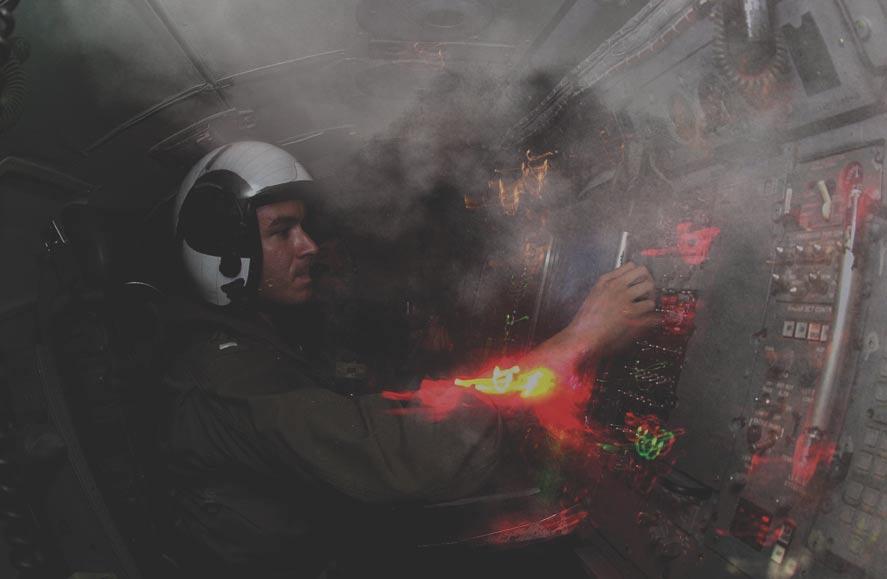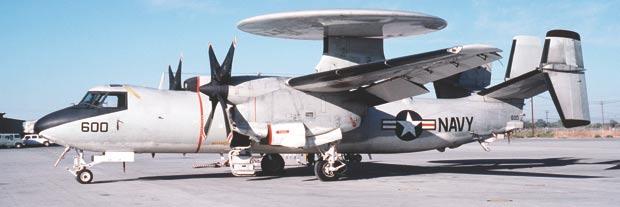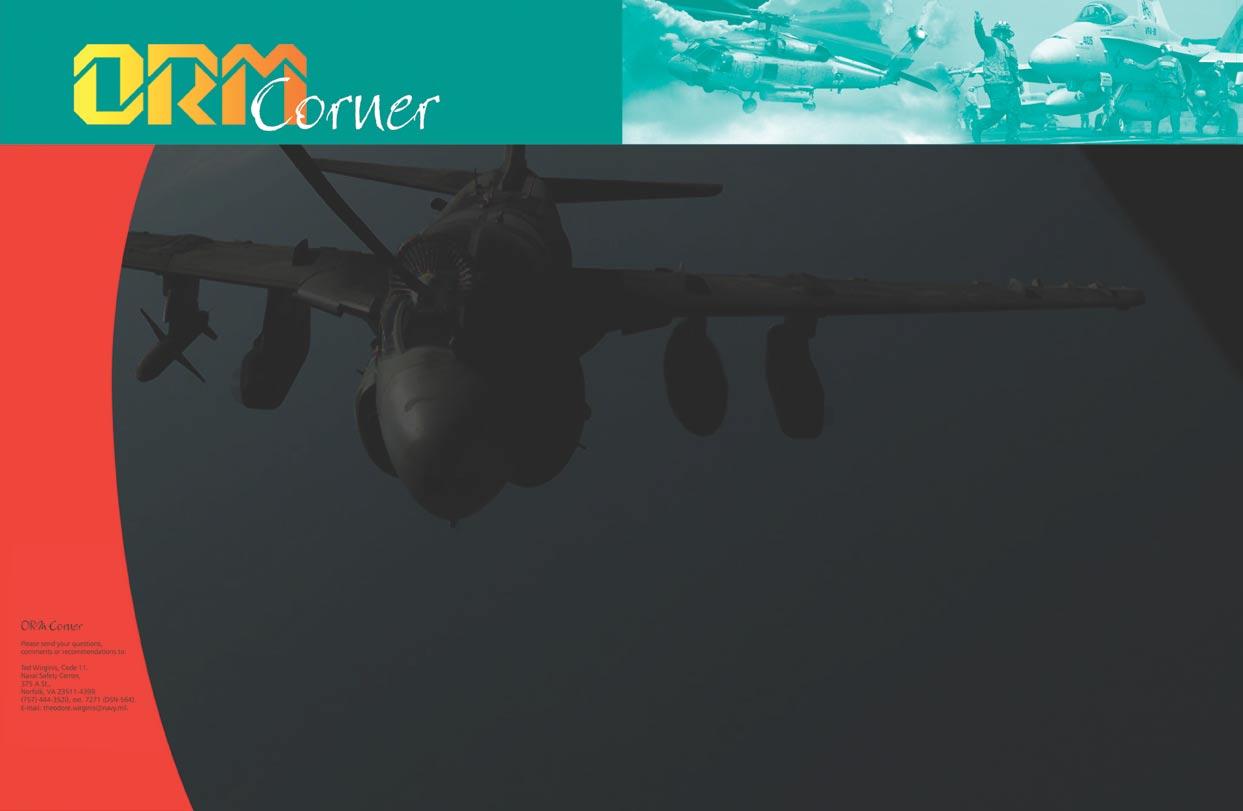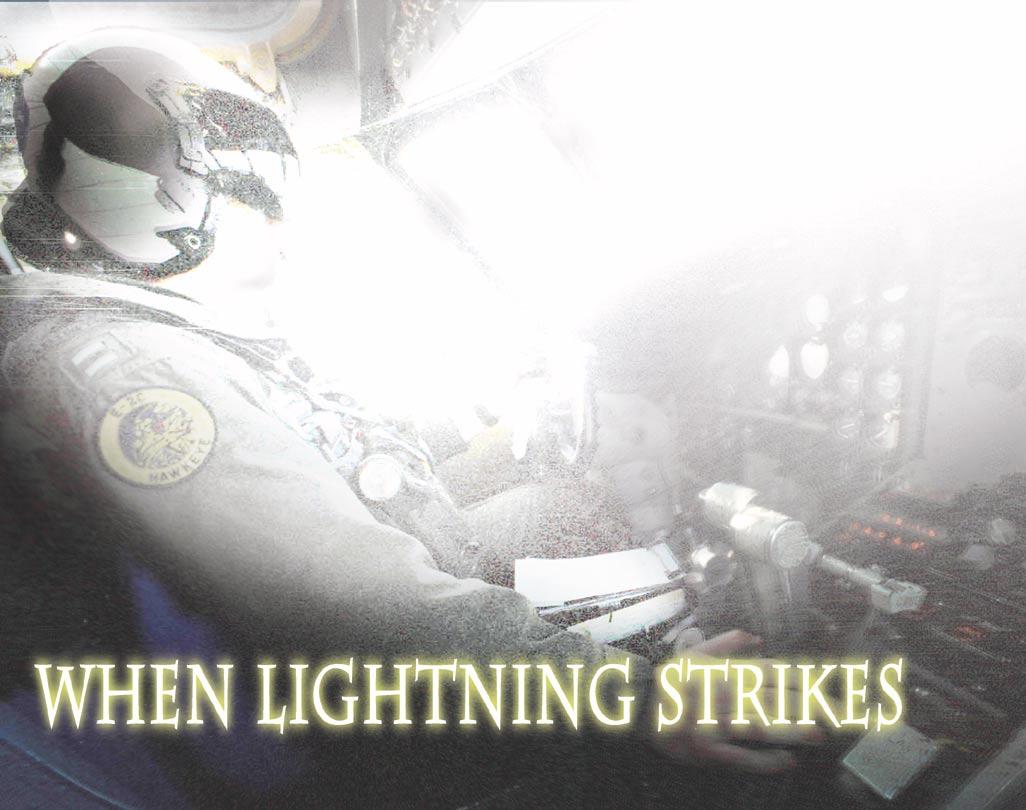
20 minute read
Smoke in the Tube
By Lt. John Gagliano
We were preparing for a detachment to NAS Fallon, to continue our work-up cycle. One of our planes, Screwtop 600, had been loaned to a sister squadron for two months because they were short a bird. However, the plane was on a 72-hour recall for possible redeployment with USS George Washington (CVN 73) battle group. When Screwtop 600 was returned to us, it required a functional-check flight (FCF) “alpha” profile.
Advertisement
I recently had received my Hawkeye aircraft-commander qualification and was working on my FCF-pilot syllabus. The four crew members for 600’s check flight were experienced O-3s, and I would sit in the left seat. All four of us had made the last cruise, where 600 had been a workhorse, but it also had required a bit more TLC than our other three aircraft.
We read the aircraft-discrepancy book, which was at least as thick as Heidi Fleiss’ black book—though not nearly as tantalizing—and walked for what would be our first man-up of the day. We started engines, and, as the pilots were completing FCF-checklist items, the NFOs suspected a bleed-air leak in the combat-information-center (CIC) compartment. The smell of 14th-stage bleed air hung in the tube, along with a smoky haze, which we also smelled in the cockpit. We secured the bleed-air switches, and the leak stopped. Troubleshooters came in to fix the problem, and we shut down without ever leaving the chocks.
On the second man-up, about two hours later, we were told the computer-environmental sensor had been replaced. The gripe was signed off, and we went flying.
After takeoff, we completed the climb checks and were passing 4,000 feet off Chambers Field (home plate) when we got master-caution and oxygen lights. The O2-quantity indicator read zero liters of LOX. We went through the non-memory items in the PCL, of which the final step is, “Land as soon as practical.”
We discussed this scenario as a crew. The individual O2 regulators displayed good pressure and produced good flow.
Smoke in the Tube
Photo by 1ST Combat Camera Squadron (D). Modified.

We also considered it practical to complete the FCF before departing for the Fallon work-ups. At the identify-hazards step in the ORM process, we recognized that if the oxygen was malfunctioning (though we didn’t think it was), we could have a problem in the event of a fire, a decompression at altitude, or a recurrence of the cabin-temperature-controller problem we had faced on deck only hours earlier. Our FCF profile, the VFR conditions, and our close proximity to home were key factors in our final decision. We had made risk decisions, implemented controls and decided to press with the FCF.
An FCF “alpha” consists of pressing every button in the aircraft, making sure every system and sub-system is checked. It is a time-consuming process, especially for the NFOs in a bird as finicky as Screwtop 600.
The cockpit checks nearly were completed; we were waiting for the NFOs to finish the FCF checklist so we could RTB. We descended to 9,000 feet to check the cabin-pressure dump. As we were reviewing the cabin-dump-FCF procedures in the cockpit, the CIC crew checked the heating-air-conditioning system. About a minute later, we heard, “Flight, CICO. We have runaway heat back here.”
We turned toward home, and, because we were below 10,000 feet, we decided to dump cabin pressure, which would help with the back-end environmental issue and also complete the cockpit checks.
A minute later, I heard, “Flight, CICO. We have smoke in the tube.”
Our preconditioned response to that statement is to complete the “smoke-fumes of unknown origin” emergency procedure. This emergency is arguably the worst to have in a Hawkeye because of the large amounts of combustible electronics and the lack of ejection seats. We rushed for our O2 masks and checked in on the O2-mask ICS, which completed the first checklist memory item.
I heard the copilot (he signed for the plane as the qualified FCF pilot) declare an emergency with ATC. I lowered the nose and accelerated toward home plate, which I saw about 25 miles away. The second memory item in the EP states, “Isolate affected equipment by pulling circuit breakers and turning switches OFF.” We turned off the air conditioning because we thought it might have been the source of the problem. The next step states, “If source cannot be immediately identified, generator switches OFF.” We briefly discussed this step but didn’t secure the generators because the smoke was not electrical in origin. The memory items continue, “Personnel air conditioning OFF” (completed), and “Cabin pressure— DUMP” (done before we started the EP).
As we executed the EP, a number of things happened simultaneously. The copilot talked to approach, while I flew and listened to him talk on the radios. The back-end crew continued to troubleshoot the smoke source (to see if the smoke actually had stopped when the AC was secured), while reviewing nonmemory items in the PCL and talking to Screwtop base. We were communicating well with each other, and our situational awareness was high.
We were set up for a direct entry to downwind, runway 28, and I pulled power to idle at midfield to slow for the landing. As I put down the gear, the backend reported, “The smoke’s clearing back here; we’re

Photo by Michael Grove
OK.” We reviewed the landing checklist three times and rolled out without incident.
The crew debrief brought out some interesting points. We performed the EP exactly as we had briefed it, with the pilot executing memory items, backed up by the CP, and the CIC crew reviewing nonmemory items, notes, warnings, and cautions. As an experienced crew, we had good individual and crew SA. Also, the smoke was not severe, nor were there any indications of a fire; however, declaring the emergency and getting on deck ASAP was the correct action.
Finally, we discussed the oxygen-system situation. What if the indication of zero liters of LOX had been correct? What if we had put on our masks and gotten a mouthful of rubber instead of O2? Fortunately, we had applied ORM to the situation and managed the risk, though we certainly did not minimize it. The E-2 has a history of mishaps resulting from smoke in the aircraft.
As a crew, we did not take the most conservative approach regarding the O2 light. In hindsight, considering this flight was an FCF “alpha,” the conservative approach would have been to land at Norfolk when the oxygen light illuminated. The E-2 has a history of mishaps resulting from smoke in the aircraft. Not having oxygen available creates a high level of risk.
When smoke did enter our aircraft, crew coordination and individual capabilities mitigated the severity of the emergency.
This flight reinforces why we conduct FCFs in the local area, in VMC, and close to a suitable field with arresting gear. The checklist is done under these conditions to manage the risk associated with an FCF profile. We complete system checks under these conditions so another crew doesn’t get the same emergency while on a mission, potentially hundreds of miles from a landing area.
ORM and FCF procedures are meant to manage risks, not eliminate them. By following procedures and applying ORM, we can operate with acceptable levels of risk, given our mission.
Lt. Gagliano flies with VAW-123.
Top Ten Tanking Troubles

By LCdr. John Flynn
At first glance, the list may seem humorous, until you realize each scenario actually occurred and, more often than not, over not-so-friendly territory.
The list was posted in our ready room. As we ended our deployment, we fondly looked back at what our squadron had accomplished, including lots of flight time, predominantly under combat conditions, and more chicken pucks than I care to mention.
I remember my crew was the only one from our squadron to divert because we could not find the tanker. In retrospect, my crew did almost everything right, and we got the skipper’s jet home because we applied the ORM principles, starting with the brief and continuing
While flying missions in support of Operation Southern Watch and Operation Iraqi Freedom, our junior officers devised a top 10 list of tanking scenarios ranked from easiest to most difficult. The objective of this ranking was to more effectively apply ORM prin- ciples, revisit fundamental proce- dures, and review policies on how to conduct refuelings.
throughout the flight.

VAQ-131 ORM Top 10
10.
9.
8.
7.
6
5.
4.
3.
2.
1. Tanking.
Tanking at night.
Tanking at night in the clouds.
Tanking at night in the clouds as a section.
Tanking at night in the clouds as a section, with only 500 feet between tankers.
Tanking at night in the clouds as a section, with only 500 feet between tankers and with no comms.
Tanking at night in the clouds as a section, with only 500 feet between tankers and with no comms, approaching bingo fuel.
Tanking at night in the clouds as a section, with only 500 feet between tankers and with no comms, approaching bingo fuel, and with the tanker starting to do S turns.
Tanking at night in the clouds as a section, with only 500 feet between tankers and with no comms, approaching bingo fuel, and with the tanker starting to do S turns when Absolute gives you a snap to your tanker, putting you back into Iraq.
Tanking at night in the clouds as a section,with only 500 feet between tankers and with no comms, approaching bingo fuel, and with the tanker starting to do S turns when Absolute gives you a snap to your tanker, putting you back into Iraq not once, but three times.
This story began during a CATCC watch earlier in the deployment, while listening to two sections and one single from other air-wing squadrons state their intentions to divert. Each crew had to ask for a latitude and longitude for the primary divert and the associated TACAN channel. Based on that event, I now questioned how familiar my squadron’s aircrew were with the operating area’s divert information. As the safety officer, I made sure the required divert information was well ingrained into the aircrew over the next few days, including location, navigation aids, field data and support facilities. Soon thereafter, the JO’s “top 10” list materialized, which I found humorous. However, I realized the importance of reviewing proper procedures should we have trouble finding the tanker’s basket, as was to occur that night.
I could say, “It was a dark and stormy night,” but, actually, we could see great with NVDs, and we planned on staying above the clouds. METOC had briefed the weather would be “scattered to broken clouds from 8,000 to 25,000 feet, with scattered rain showers in the central and western portions of the AOR.”
“Great,” we thought, “right in the middle of all the tanker tracks.”
After our brief and a review of the aircraft-discrepancy book, we again launched in support of the “shock and awe” phase of OIF. We easily found our front-side tanker with the help of the NVDs, but the tanker pilot wanted to stick to his assigned track, which meant going through (instead of around) cumulus clouds. We got our gas and proceeded to station. Along the way, we climbed, then climbed some more—all the way to a very untactical FL320. From there, we provided jamming support before leaving to find our midcycle tanker.
We had heard from another Prowler crew that the weather between FL260 and FL280 was workable, at least partly VMC. We had the E-3 clear the path in front of us, and we found ourselves descending and ascending between FL200 and FL300 to find VFR conditions. We finally found a clear altitude at FL260 and turned toward the tanker track.
One radio was tuned to the tanker-control frequency and the other radio directly to the tanker. The tanker crew said they were IMC at FL220. We got a sweet lock on him at 35 miles and asked the controller for a SNAP (bearing, distance and altitude). The tanker crew said they were climbing to FL240 because FL220 was unworkable. We got our SNAP from the controller and descended to FL230.
Looking at the “top 10” list, we had experienced Nos. 10, 9, and 8. Fortunately, we were not in a section, but we were about to experience numbers 4 and 3, although we were told no other tankers were in the vicinity. We had excellent comms with the tanker and the controllers as they fought to have a Prowler meet a VC-10.
I could see the TACAN quickly tick down, indicating a head-to-head pass was coming. As it ticked down to 1.5 miles, with no tanker in sight—we still were in the clouds at FL230 feet—I started to get worried. My pilot put on a hard turn, and we got an updated steer to the tanker, 180 degrees behind us. The VC-10 pilot tried various altitudes and headings but could not find a clear area. The tanker crew suggested we simply follow him via TACAN as he flew back to his base, and, if we broke out, then we could get our gas. With no other tankers available, this plan seemed like our final option.
I asked for another SNAP to our VC-10 and his heading. I noted the TACAN read 7.5 miles. From the information we received from the controller and the VC-10, the crew figured we were behind our tanker. We increased speed but watched the TACAN gradually increase, which did not make any sense, so I again asked for the VC-10’s heading and airspeed. They were on our heading and about 50 knots slower than us. The controller swore that the VC-10 still was in front of us. About that time, we hit strong rain showers, and I swore to myself. Our squadron just had experienced a flight involving severe hail damage, so getting hit by hail was not good. The rain subsided occasionally but then came back with ferocity. Meanwhile, the TACAN still was increasing, even as we slowed. We had calculated our bingo number to be 4,500 pounds; we were showing 5,500 pounds. With the confusion over the tanker’s location, and after dueling with the controller and the tanker, I asked, “OK, who has had enough of this?” My pilot immediately raised his hand.
We eventually correlated the TACAN with what the controller and the tanker pilot were saying. Finally, I realized we were probably on slightly diverging flight paths; hence, the increasing TACAN, despite our speeding or slowing. I cried “uncle” with 5,000 pounds remaining and announced we were diverting. My pilot climbed at 0.7 Mach to FL330, and we finally were above the clouds.
I told the controller we were “emergency fuel” and were heading to our primary divert. I knew that, technically, we gave up 500 pounds early, but I added a few
hundred pounds for my very pregnant wife (she gave birth to our twin boys four days later) and because the tanker duel had proved fruitless.
Knowing we had gas for our divert and plenty of tailwind, we flew via deconflicted routing to the divert field. I coudn’t establish communications with our foreign air-traffic controller, so I switched up approach and the supervisor of flying (SOF) at our divert field. The SOF expected us, and he said fuel was waiting upon our arrival, and the ship knew our divert plan. Just as the SOF gave us that message, the clouds disappeared below us, and we could see forever.
My pilot was busy reading the approach plate and getting positioned for an idle descent, while I talked on the radios. As we descended, the approach controllers asked if we had the field in sight. All we could see were a bunch of lights perpendicular to our flight path. From our earlier review of the airfield layout, we knew the runways were perpendicular to our flight path. We correctly surmised the lights were from the airfield facilities. However, we could not make out the runway lights. We knew from the field diagram the runway was west of the facility lights. As we turned to final, the runway lights appeared, with our fuel now down to 2,400 pounds. We were going to op-check some of our landing items that had not been used in five months, namely the anti-skid and the flaperon pop-ups.
My pilot configured the aircraft for landing, and we immediately got an anti-skid light. Fortunately, it had not been raining at the airfield, and tower confirmed a dry runway. My pilot flew a low glide slope to touchdown, using the VASI-light system. The aircraft touched down on the dry runway, and my pilot and I reported good pop-ups to complete a successful landing. Ground control directed us to the transient line, where we shut down with 1,700 pounds of gas and no low-fuel light.
It took us longer to get the gas we wanted. We were out of practice for what amounted to cross-country rules. But, we got enough gas to get to the ship and thanked the Marines who helped us out. I had to blow the dust off my ground-based checklists. We got airborne and made our assigned recovery time to an OK 3-wire.
I would like to impress on others these points: • Know your operating-area-divert information: latitude and longitude, runway and field data, and available navaids and communications frequencies. • Communicate within the squadron and air wing. Many of the flights conducted during Operation Iraqi Freedom were flown in IMC and led to a number of diverts. I learned from others in the air wing some of the nuances of the divert fields that are otherwise not available from the publications. I then passed those lessons to others in my squadron. • Compartmentalization can be critical. I always have felt comfortable with my ability and my crew’s ability to compartmentalize, and this flight was no exception. Not only was the flight a combat mission, but my wife back at home was about to give birth. Yet, my crew and I knew exactly where we were and what we had to do to get home. • Know when to say “when.” I had heard of others getting below bingo fuel before finding the tanker, but I was not about to let that happen this night. Confusion as to where the tanker was, IMC flight, and rain, were factors that led our crew to say “when” at the appropriate time. • Once the decision is made to divert, then divert. Our airborne controllers asked if we wanted to try to find a tanker south of our flight path. Knowing we really had 500 pounds of gas to play with (about five minutes), we declined. • Crew coordination is always a factor in the EA-6B. I had our backseaters figure out our actual bingo fuel. Once we started the divert procedure, I let them know our intentions and kept them abreast of what we were seeing on approach. • Be prepared. I always carry the necessary publications with me, regardless of the flight’s length, complexity or location, and I thoroughly review divert data. Looking at the pubs for the first time at night or IMC on a bingo profile is not good preparation. • Look for safety-of-flight clues any place you can. The JO’s ORM “top 10” list, although humorous, highlighted our most prevalent risk during Operation Iraqi Freedom: IMC tanking.
Always assess the risks, and address those risks to best mitigate them, if not remove them completely. Inflight tanking will continue to be a challenge, especially in aircraft like the Prowler, which lacks air-to-air radar to facilitate rendezvous in IMC conditions.
Dependency on air-traffic controllers can be fatal if a fully developed plan of action has not been discussed. Knowledge of local operating areas and divert fields are a must, whether operating in the United States or in combat conditions. Can you avoid disaster when one of those “top 10” flights comes your way?
LCdr. Flynn flies with VAQ-131.
Situational Awareness Assertiveness Decision Making Communication Leadership Adaptability/Flexibility Mission Analysis
CRM Contacts:
Lt. Dave Messman, OPNAV CRM Resource Officer (703) 604-7729, (DSN 664) david.messman@navy.mil ATC(AW) Douglas Thomas, NAVAIR (301) 757-8127 (DSN 757) CRM Program Manager douglas.thomas@navy.mil CRM Instructional Model Manager NASC Pensacola, Fla. (850) 452-2088/5567 (DSN 922) https://wwwnt.cnet.navy.mil/crm/ LCdr. Deborah White, Naval Safety Center (757) 444-3520, Ext.7231 (DSN 564) deborah.j.white@navy.mil
By Lt. Erich Roetz

Here I am—airborne, on cruise for the first time in three years, and trying to get night qualified. What can go wrong?
As the mission starts, I realize I’m a little tired. I can’t imagine why. Five days ago, I was an FRS instructor on the East Coast. Now, I’m briefing my second flight of the day in the central Mediterranean
Sea. Knowing I am near my limits, I ask the aircraft commander (a pilot junior to me by about 1,500 hours) to keep an eye on me.
The mission is uneventful and almost over. We check through strike and into marshal; I had forgotten how quickly they pass the instructions. We start to experience poor weather, as forecasted.
As we head for marshal, my copilot asks for my airspeed. I respond, “200 knots, why?”
He replies, “I’m showing about 150 knots and decreasing.” Uh oh, not a good sign.
When his airspeed reaches zero, I think, “No big deal. I’ve been single-piloted with students at the FRS for the last couple of years.”
As we proceed to our marshal point, the weather gets worse. Our storm scope is on, but it is not a true weather radar. Only electrical discharges are displayed, and the scope shows nothing. However, we are getting bounced around pretty good. All I can think is, “Just fly attitude.” It is getting darker, and I have no copilot instruments to back me up. It would be nice to have back his instruments.
The next thing I hear from the right seat is, “Hey, look at this,” as he points to the windscreen. I see Saint Elmo’s fire. Then everything goes white, I hear a huge crack, and the aircraft shakes violently.
I say the first thing that comes to mind, “I can’t see.”
My copilot then says the first thing that comes to his mind, “Whoa, I can’t see either.” Not good: Two blind pilots, and only one of us is an LSO.
As my vision slowly comes back, I stay on instru

ments. I feel I should state the obvious, “We were struck by lightning.” Our next task is to determine what still works. After careful scrutiny, we realize we have all of our navigational aids. We then want to see if there is any structural damage, so we dirty up. Everything is going well, but still I can’t see very well.
The copilot then exclaims, “Hey, my instruments are back.” More good news, I think. Although I am happy his instruments have returned, I would prefer they hadn’t come back than to have suffered a lightning strike.
We fly around mom at 2,000 feet, which gives us more time to get back our vision, and we land for an uneventful night trap.
As we taxi out of the landing area, I remember something from primary that would have been useful 30 minutes earlier: Do not let anyone put you in a situation that is unfavorable to good aviation. If we had told marshal our radial was in the middle of a strong weather cell, we could have received alternate marshal instructions.
I still wasn’t night qualified because I needed two night traps, so the Hawkeye rep asked if I wanted to swap aircraft to get a second night trap. My rough translation over the radio was, “No thank you.”
That decision probably was the best one we made all evening.
Lt. Roetz flies with VAW-124.









